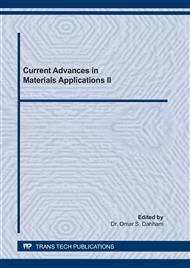p.260
p.270
p.280
p.290
p.299
p.308
p.317
p.327
p.335
The Effects of Stearic Acid (SA) on the Thermal and Physical Properties of LLDPE/DS Composites
Abstract:
In this study, polymer composites were synthesized from date seeds (DS) powder as natural filler and low-density polyethylene (LLDPE) as polymer matrix. This composite was exposed into chemical modification using different content of Stearic Acid (SA) (3, 6 and 9 wt.%). The composite was fabricated by using the process of extrusion and injection molding respectively. The prepared samples were examined using TGA, DSC, FTIR, and Gel Content test. It can be clearly observed that all the treated samples have presented three-steps of decomposition as shown in TGA curves. It is also observed that the Tm, Tc, and degree of crystallinity of the modified LLDPE/DS biocomposites increased as SA increase. Thr FTIR spectra have shown different type of stretching bands, the band at 3346 - 3347 cm-1 appeared because of hydroxyle (OH) groups that is described as a hydrophilicity measure. Beside, there was a minor decrease on the peak between 3346 and 3347 cm-1 of modified composite, whichwas attributed to the hemicellulose removal from the modified composite. The gel content of the treated mples increased due to the increase of crosslinking between DS and LLDPE in existence of SA.
Info:
Periodical:
Pages:
299-307
Citation:
Online since:
February 2021
Authors:
Keywords:
Price:
Сopyright:
© 2021 Trans Tech Publications Ltd. All Rights Reserved
Share:
Citation:


